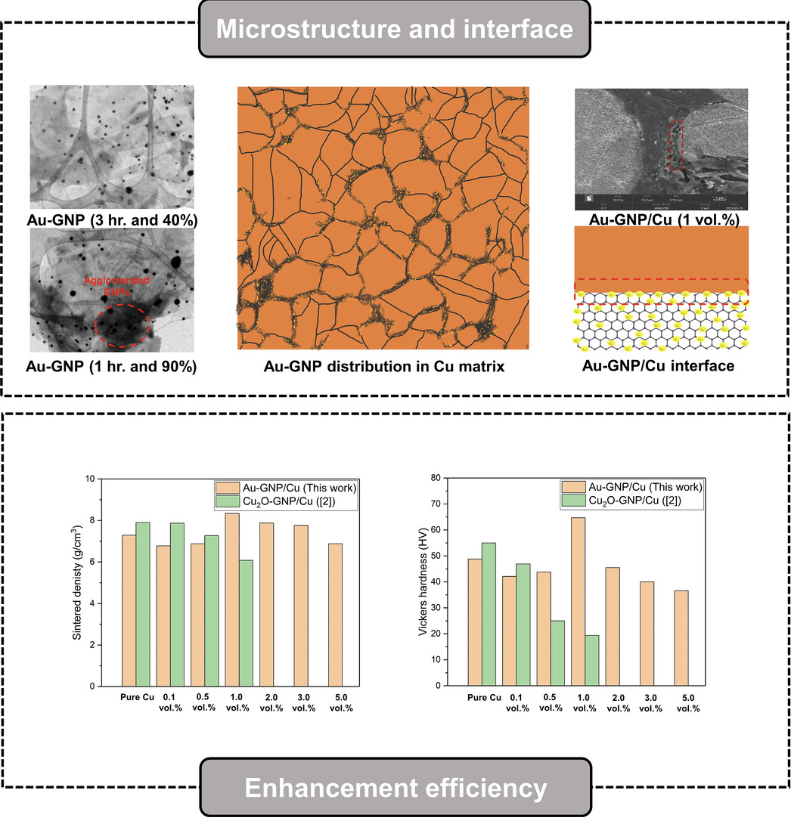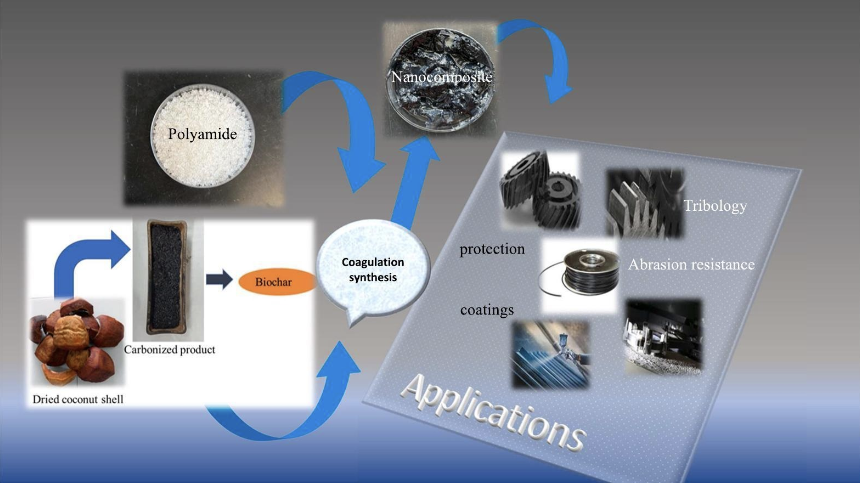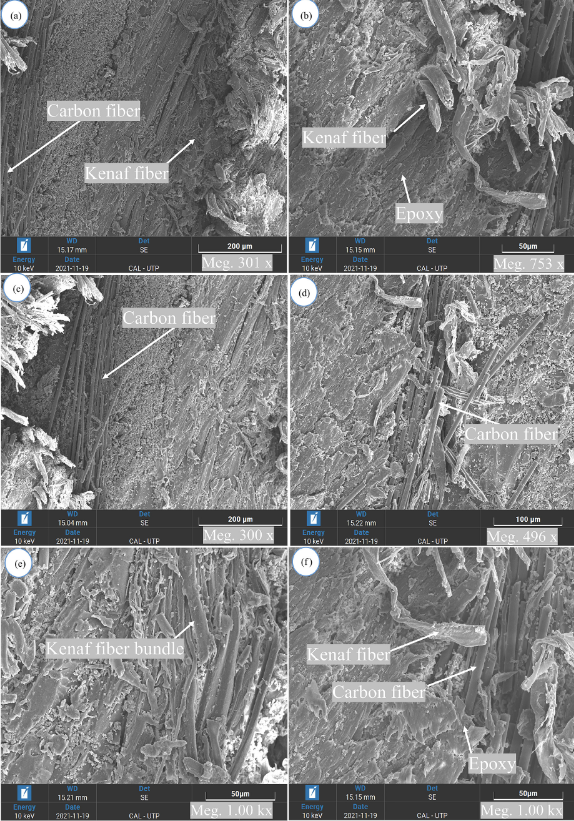Research Success Stories
The interfacial interaction between graphene and Cu restricts the efficacious properties' enhancement due to poor wettability between the reinforcement and matrix. Herein, we reported an interface modification strategy by Au decoration of graphene nanoplatelets (Au-GNPs) without carbide/oxide formation. Sonication was used to induce defects in GNPs, which were then decorated with Au nanoparticles and used to fabricate a composite material with Cu (Au-GNP/Cu) via low pressure cold pressing and sintering. Sonication parameters' optimization depicted higher exfoliation of GNPs with lower defects at lower sonication amplitude and higher sonication duration which resulted in relatively monodispersed Au nanoparticles attached to the GNPs' surface. The Au-GNP/Cu composite with 1 vol% showed highest sintered density, hardness and calculated tensile strength which decreased at higher Au-GNP content. The proposed interface design with noble metal nanoparticles acting as bridges between GNP and Cu, opens new horizons for superior mechanical properties of composites.
Posted on: December 2023
Authored: Faiz Ahmad
This research was intended to investigate the thermal, morphological, and crystalline characteristics of polyamide-6@carbon char-based nanocomposites. The mesoporous nanosized carbon char was prepared in the laboratory via the carbonization method. The parameters of the coconut shell-based biocarbon char were confirmed by surface area and particle size analysis, and X-ray diffraction analysis. The coagulation-processed nanocomposites of polyamide-6 were prepared using synthesized mesoporous carbon char as filler. The obtained filler with a Brunauer-Emmett-Teller surface area of 1517 m2/g and an average pore volume of 2.51 nm was mixed with the polyamide at five different loadings. The coagulation technique was employed for the nanocomposite synthesis. The acquired coagulated nanocomposite was investigated using Fourier transform infrared analysis, thermogravimetric analysis, differential scanning calorimetric technique, and scanning electron microscopy analysis. It was evidenced from the research that loading coconut shell-based carbon char to polyamide-6 can contribute to a 10 °C rise in final degradation temperature with a 4 % loading of filler. The same filler content has contributed to a 5 °C decline in glass transition temperature. A continuous decrease in crystallinity with a rise in the concentration of biochar is indicative of the incorporation of amorphous character. So, it was determined that the thermal, morphological, and crystalline properties have been modified by synthesizing the coagulation-processed nanocomposites with mesoporous biochar of coconut shells.
Posted on: October 2023
Authored: Faiz Ahmad
A comparative study of epoxy filled graphene oxide (GO) and montmorillonite (MMT) and its combination on the flame retardancy and thermal stability of epoxy nanocomposite coatings has been investigated. Limiting oxygen index (LOI) and thermogravimetry analysis (TGA) were carried out to determine the flame retardancy and thermal stability properties and clarifying the correlations between different nanofillers fraction. The result suggests that the formation of an efficient hybrid network evidenced by enhanced the flame retardancy as well as thermal stability performance of epoxy nanocomposite coating. The adhesion tape test results revealed that hybrid nanofillers exerts an obviously synergistic effect, demonstrated by the increased in adhesion strength compare to a single nanofillers. Transmission electron microscopy (TEM) revealed a high dispersion of hybrid GO/MMT due to the physical interaction between the nanofillers and epoxy matrix, responsible for the improved of coating's performance.
Posted on:2021
Authored: Faiz Ahmad
Single-kenaf fiber-reinforced polymer composites are typically characterized by relatively low strength and stiffness properties that make them unsuitable for structural applications. However, they are lightweight, economical, and ecofriendly. This paper presents a study on the manufacturing and mechanical characterization of bidirectional kenaf (K) fiber-reinforced epoxy composites hybridized with carbon (C) fibers in various stacking sequences and the effects of hybridization on salient physical and mechanical properties. Single and hybrid fiber composites were fabricated utilizing the vacuum infusion molding technique. The density, tensile, flexural, and interlaminar shear properties in hybrid composites increased significantly when carbon fiber volume increased from 9% to 16%. Stacking sequences in a hybrid affected the mechanical properties of the composites. The highest tensile strength and modulus were shown by the seven-layer hybrid composite with an alternate K/C stacking sequence and C layers as skin layers, i.e., C/K/C/K/C/K/C, among all tested hybrid composites. Sandwich design in the hybrid (C2/K3/C2) had higher flexural strength (+300%), flexural modulus (+414%), interlaminar shear strength (+278%), lower water absorption (-46%), and thickness swelling (-30%) compared to single-fiber kenaf/epoxy composites. Density increased by 5% in hybrid composites. The highest fracture toughness (+134%) was achieved using the dual sandwich design structure hybrid (C/K2/C2/K2/C). The developed composite has applications in stairways, walkways, and bridges.
Posted on: November 2023
Authored: Faiz Ahmad
The process of Thermal spray is effective for creating a metal matrix composite (MMC) by embedding zirconium diboride reinforcement into a molybdenum matrix. Both materials Mo and ZrB2 have different characteristics, but they have good thermal shock resistance, maintain strength at elevated temperatures, and stability in extreme environments. The study focused on creating MoZrB2 composites using a thermal spray coating technique, varying the parameters of spraying distance, number of passes, and gas pressure, and testing the resulting castings to evaluate their hardness and Young's Modulus. The primary objective of the research was to use the Taguchi technique for identifying the optimal parameters for generating the highest Young's Modulus and hardness for the castings. The Taguchi method integrates experimental and analytical principles to identify the most significant parameter affecting the response, which can significantly enhance overall performance. The study found that the optimal parameters were a spraying distance of 20 cm, gas pressure of 6 bar, and the number of passes of 18. The Taguchi method accurately predicted the parameters that produced the highest properties for the composite coatings, which demonstrated good surface formation without hot cracks and fewer pores, with well-formed metallurgical bonding between the coating and the substrate.p>
Posted on: September 2023
Authored: Faiz Ahmad




